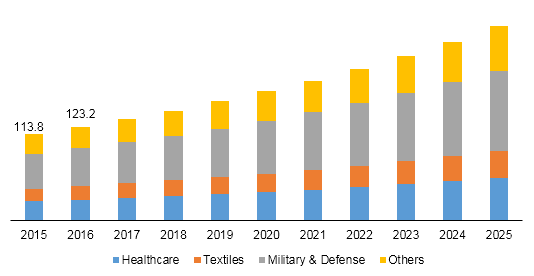
Global Microwave Absorbers Market Size and Forecast, By Product (Reflectivity, Magnetic, Dielectric), By Application (Textiles and Military & Defense), And Trends Analysis, 2015 - 2025
- Published: October, 2018
- Format: Electronic (PDF)
- Number of pages: 66
- Industry: Advanced Materials
Industry Insights
The global microwave absorbers market size was valued at USD 133.5 million in 2017. It is expected to exhibit promising growth through 2025. Growing demand for insulation owing to involvement of various microelectronics such as processors and other components is expected to fuel the demand. Additionally, installation of various micro components in circuits of electronics and aircraft cabins is anticipated to drive the market. These micro components radiate various frequencies that cause malfunction of systems and project improper data representation to users.
Global microwave absorbers market revenue, by application, 2015 - 2025 (USD Million)

In order to prevent inappropriate data representations, microwave absorbers are incorporated across the textile and military and defense industries. They create an empty space in anechoic chamber by removing reflections. Growing demand for light-weight and broadband products owing to rising need for defense security and electronic reliability is one of the key factors driving the market.
Light-weight absorbers were designed in X band based on polyaniline manganese nickel zinc ferrite nanocomposites. Additionally, various funds are being granted for conducting research and development (R&D) activities related to them.
For instance, in August 2017, the National Science Foundation (NFS) granted a fund of USD 224,000 to TangiTek, LLC for development of 3D flocked carbon fiber microwave absorber. Key objective was to develop lightweight and thin materials capable of RFI/EMI absorption without adding additional weight to product.
Manufacturers are implementing high-performance microwave absorbers in aircraft that has resulted in continuous improvement in radar detection devices. This will help in preventing detection of aircrafts on radar and making aircrafts efficient for stealth missions. Lucrative demand for stealth aircrafts owing to growing needs for national security is expected to fuel the market growth in the forecast period.
Segmentation by Product
• Reflectivity Absorbers
• Insertion Loss Absorbers
• Magnetic Microwave Absorbers
• Dielectric Microwave Absorbers
The magnetic segment is expected to register a CAGR of 8.7% during the forecast period owing to light-weight nature than their counterparts. This product type is significantly used in aircraft building. Expansion in global fleet of commercial and military aircrafts is expected to supplement the growth of the segment. Moreover, increasing complexity of cabin equipment such as sensors, radar systems, microprocessors, and peripherals is projected to improve their penetration in the aviation sector.
Reflectivity absorbers, when applied to a metal plate, minimize reflections from an incoming wave. Surging demand for sheet type of products is estimated to trigger the demand for reflectivity absorbers over the forecast period. Moreover, increasing usage of microprocessors, chips, and other EMI creating materials in circuits is likely to contribute to the growth of the segment. One of the key players involved in manufacturing reflectivity RF absorbers is Cuming Microwave Corporation.
Segmentation by Application
• Electronics and Telecommunication
• Healthcare
• Textiles
• Military and Defense
• Others
The military and defense segment dominated the market in 2017 and accounted for more than 28.0% of the overall market. The segment is anticipated to witness tremendous growth during the forecast period. Properties such as energy reduction in an electromagnetic wave is one of the key factors fueling the demand for the product in the defense sector.
Electronics and telecommunication is estimated to emerge as the fastest-growing segment during the forecast period, with a CAGR of 8.6%. The growth of the segment can be attributed to rising usage of RF absorbing materials in various electronic devices as they eliminate surplus radiations that may interfere with a system’s process.
Segmentation by Region
• North America
• Europe
• Asia Pacific
• Rest of the World
In 2017, North America accounted for more than 40.0% of the market value, followed by Europe and Asia Pacific. Robust growth of end-use sectors such as military, consumer electronics, and automotive is one of the primary growth stimulants for the regional market. Furthermore, strong presence of key players in the region is poised to augment the market.
Asia Pacific is anticipated to be the most promising region in the microwave absorbers market during the forecast period owing to rising consumer spending on products such as smartphones, smartwatches, and smart televisions.
Furthermore, growing mobile communication and rising usage of media channels are resulting in increase in incorporation of air space. Development of sophisticated products is anticipated to fuel demand for RF absorbers in Asia Pacific.
Competitive Landscape
The microwave absorbers market is marked by presence of well-established players as well as regional and domestic players. Some of the leading companies operating in the market are Cuming Microwave Corporation, Laird Technologies, and ARC Technologies. Majority of the players are offering their products online through individual e-commerce platforms in order to minimize supply chain and strengthen their presence in the market.
Companies are taking up strategies such as product innovation and merger & acquisitions (M&A). Additionally, various universities and research institutions are actively working on research and development (R&D) activities for new product designing to offer light-weight and narrowband absorbers to end users. For instance, graphene-based products are being researched in order to overcome heaviness of traditional absorber sheets.

Choose License Type
- World's largest premium report database
- Transparent pre & post sale customer engagement model
- Unparalleled flexibility in terms of rendering services
- Safe & secure web experience
- 24*5 Research support service
